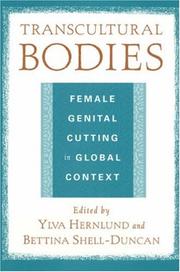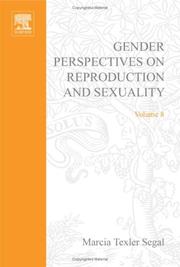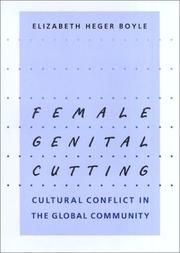| Listing 1 - 9 of 9 |
Sort by
|
Book
ISBN: 3863882644 3863887077 Year: 2015 Publisher: Leverkusen Budrich UniPress
Abstract | Keywords | Export | Availability | Bookmark
 Loading...
Loading...Choose an application
- Reference Manager
- EndNote
- RefWorks (Direct export to RefWorks)
Weibliche Genitalbeschneidung ist ein Phänomen, das aus verschiedenen Perspektiven betrachtet unterschiedliche Reaktionen hervorruft. Wie erleben betroffene Frauen mit somalischer Herkunft die Praktik im Kontext von Migration? Und welchen Blick haben Fachkräfte der Sozialen Arbeit und migrierte somalische Männer auf weibliche Genitalbeschneidung? Insgesamt wird deutlich, dass die Perspektive betroffener Frauen und Männer in der Sozialen Arbeit in Zukunft deutlich mehr berücksichtigt werden muss. Female circumcision is a phenomenon that causes different reactions from different perspectives. How do Somali women experience the practice in the context of migration? And what view do social workers and migrated Somali men have of female circumcision? Overall, it is clarified that the perspective of affected women and men in social work will have to be given much more future consideration. So unterschiedlich die Persönlichkeiten und Biographien der GesprächspartnerInnen, so vielfältig sind deren Aussagen. Dennoch wird klar: Nachwievor sind Hebammen und GynäkologInnen zu wenig über weibliche Genitalbeschneidung informiert und verhalten sich Betroffenen gegenüber all zu oft unangemessen, ja herablassend. Aber eine maßgebende Voraussetzung für die Akzeptanz von Aufklärungsbemühungen ist ein offener, wertschätzender Kontakt auf Augenhöhe. frauenrechte.de, 01/2016
Gender studies: women --- Female circumcision --- Circumcision, Female --- Clitoridotomy --- Female genital cutting --- Female genital modification --- Female genital mutilation --- FGC (Female genital cutting) --- FGM (Female genital mutilation) --- Genital cutting, Female --- Genital mutilation, Female --- Mutilation, Female genital --- Body marking --- Clitoris --- Initiation rites --- Surgery --- circumcision --- Female Genital Mutilation --- Migration --- Normativity --- Normativität --- Somalia --- Weibliche Genitalverstümmelung --- Weibliche Genitalverstümmelung --- Normativität


ISBN: 1281092568 9786611092566 0813541387 9780813541389 0813540259 9780813540252 0813540267 9780813540269 9781281092564 Year: 2007 Publisher: New Brunswick, NJ
Abstract | Keywords | Export | Availability | Bookmark
 Loading...
Loading...Choose an application
- Reference Manager
- EndNote
- RefWorks (Direct export to RefWorks)
Female "circumcision" or, more precisely, female genital cutting (FGC), remains an important cultural practice in many African countries, often serving as a coming-of-age ritual. It is also a practice that has generated international dispute and continues to be at the center of debates over women's rights, the limits of cultural pluralism, the balance of power between local cultures, international human rights, and feminist activism. In our increasingly globalized world, these practices have also begun immigrating to other nations, where transnational complexities vex debates about how to resolve the issue. Bringing together thirteen essays, Transcultural Bodies provides an ethnographically rich exploration of FGC among African diasporas in the United Kingdom, Europe, and Australia. Contributors analyze changes in ideologies of gender and sexuality in immigrant communities, the frequent marginalization of African women's voices in debates over FGC, and controversies over legislation restricting the practice in immigrant populations.
Infibulation. --- Female circumcision. --- Labiorrhapy --- Female circumcision --- Vulva --- Circumcision, Female --- Clitoridotomy --- Female genital cutting --- Female genital modification --- Female genital mutilation --- FGC (Female genital cutting) --- FGM (Female genital mutilation) --- Genital cutting, Female --- Genital mutilation, Female --- Mutilation, Female genital --- Body marking --- Clitoris --- Initiation rites --- Surgery --- Female genital mutilation.

ISBN: 9786611016135 0080472842 076231088X 9780080472843 Year: 2004 Publisher: Amsterdam Boston Elsevier JAI
Abstract | Keywords | Export | Availability | Bookmark
 Loading...
Loading...Choose an application
- Reference Manager
- EndNote
- RefWorks (Direct export to RefWorks)
This volume offers feminist perspectives on the social, cultural and medical aspects of women as sexual beings and of their fertility, pregnancy and child bearing. It serves as a companion to Advances in Gender Research volume 7, Gender perspectives on Health and Medicine: Key Themes.
Women's rights. --- Childbirth --- Midwifery --- Obstetrics --- Human reproduction --- Female circumcision. --- Social aspects. --- History. --- Circumcision, Female --- Clitoridotomy --- Female genital cutting --- Female genital modification --- Female genital mutilation --- FGC (Female genital cutting) --- FGM (Female genital mutilation) --- Genital cutting, Female --- Genital mutilation, Female --- Mutilation, Female genital --- Society and obstetrics --- Birth --- Birthing --- Child birth --- Live birth --- Rights of women --- Women --- Women's rights --- Civil rights --- Law and legislation --- Body marking --- Clitoris --- Initiation rites --- Nursing specialties --- Midwives --- Parturition --- Labor (Obstetrics) --- Human rights --- Surgery --- Legal status, laws, etc. --- Female circumcision --- Female genital mutilation.

ISBN: 0801874734 9780801874734 9780801870637 0801870631 080188263X 9780801882630 Year: 2002 Publisher: Baltimore The Johns Hopkins University Press
Abstract | Keywords | Export | Availability | Bookmark
 Loading...
Loading...Choose an application
- Reference Manager
- EndNote
- RefWorks (Direct export to RefWorks)
She concludes that while globalization may exacerbate such conflicts, it can ultimately lead to social change.
Female circumcision --- World health. --- Global health --- International health --- Public health --- Medical geography --- Circumcision, Female --- Clitoridotomy --- Female genital cutting --- Female genital modification --- Female genital mutilation --- FGC (Female genital cutting) --- FGM (Female genital mutilation) --- Genital cutting, Female --- Genital mutilation, Female --- Mutilation, Female genital --- Body marking --- Clitoris --- Initiation rites --- Prevention. --- Government policy. --- Religious aspects. --- International cooperation --- Surgery --- World health --- vrouwenbesnijdenis --- Government policy --- Prevention --- Religious aspects --- excision (circoncision féminine) --- Excision (Ethnologie) --- Santé mondiale --- Prévention --- Politique gouvernementale --- Aspect religieux --- Social policy --- Human rights --- Physiology: reproduction & development. Ages of life --- International --- Book
Book
ISBN: 3658127228 3658127236 Year: 2016 Publisher: Wiesbaden : Springer Fachmedien Wiesbaden : Imprint: Springer VS,
Abstract | Keywords | Export | Availability | Bookmark
 Loading...
Loading...Choose an application
- Reference Manager
- EndNote
- RefWorks (Direct export to RefWorks)
How is it possible to fight against Female Genital Mutilation (FGM) without disrespecting traditional values? This study analyses ‘film’ as a tool for Human Rights Education in Burkina Faso, especially when it includes thought structures of the local communities. Here, the innovative approach of ciné débat, a particular cinematic awareness-raising strategy is applied and analysed. Thus, this research describes how a documentary film about FGM in Burkina Faso was produced and presented. It is believed that the critical reconsideration of one’s own thoughts represents a prerequisite for changing habits. The aim is to find solutions within the traditional context of the country, not to dictate or instruct behaviour patterns to the locals. Contents Universal rights versus cultural relativism Human rights education through film Women’s rights and FGM in Burkina Faso Ciné débat and traditional debating habits Target Groups Researchers and practitioners in political sciences, human rights education, gender, and development cooperation International organisations with the focus on FGM and women’s rights About the Author Johanna Richter obtained a PhD in Political Sciences at the UNESCO Chair of Human Rights Education. She travels frequently to West Africa, and has been researching the topic of gender in Burkina Faso for over 10 years. She has worked on various science documentaries for TV.
Social sciences. --- Social work. --- Sociology. --- Cultural studies. --- Sex (Psychology). --- Gender expression. --- Gender identity. --- Social Sciences. --- Gender Studies. --- Social Work. --- Cultural Studies. --- Female circumcision --- Prevention. --- Circumcision, Female --- Clitoridotomy --- Female genital cutting --- Female genital modification --- Female genital mutilation --- FGC (Female genital cutting) --- FGM (Female genital mutilation) --- Genital cutting, Female --- Genital mutilation, Female --- Mutilation, Female genital --- Sex identity (Gender identity) --- Sexual identity (Gender identity) --- Identity (Psychology) --- Sex (Psychology) --- Queer theory --- Expression, Gender --- Sex role --- Psychology, Sexual --- Sex --- Sexual behavior, Psychology of --- Sexual psychology --- Sensuality --- Social theory --- Social sciences --- Benevolent institutions --- Philanthropy --- Relief stations (for the poor) --- Social service agencies --- Social welfare --- Social work --- Human services --- Behavioral sciences --- Human sciences --- Sciences, Social --- Social science --- Social studies --- Civilization --- Psychological aspects --- Body marking --- Clitoris --- Initiation rites --- Surgery
Book
ISBN: 0896804976 9780896803091 9780896803107 9780896804975 0896803090 0896803104 Year: 2016 Publisher: Athens, Ohio
Abstract | Keywords | Export | Availability | Bookmark
 Loading...
Loading...Choose an application
- Reference Manager
- EndNote
- RefWorks (Direct export to RefWorks)
Why do female genital cutting practices persist? How does circumcision affect the rights of girls in a culture where initiation forms the lynchpin of the ritual cycle at the core of defining gender, identity, and social and political status?
Female circumcision --- Circumcision --- Kuria (African people) --- Rites and ceremonies. --- Social life and customs. --- Abakuria (African people) --- Bakulia (African people) --- Bakuria (African people) --- Batende (African people) --- Ikikuria (African people) --- Kurya (African people) --- Amputation, Foreskin --- Foreskin amputation --- Foreskin removal --- Male circumcision --- Prepucectomy --- Removal of foreskin --- Circumcision, Female --- Clitoridotomy --- Female genital cutting --- Female genital modification --- Female genital mutilation --- FGC (Female genital cutting) --- FGM (Female genital mutilation) --- Genital cutting, Female --- Genital mutilation, Female --- Mutilation, Female genital --- Ethnology --- Body marking --- Foreskin --- Initiation rites --- Clitoris --- Surgery --- Kenya. --- Cenia --- Chenia --- Colony and Protectorate of Kenya --- GOK --- Government of Kenya --- Jamhuri ya Kenya --- Kenia --- Kenii︠a︡ --- Kenniya --- Kenya Colony and Protectorate --- Ḳenyah --- Kīniyā --- Kīnyā --- Quênia --- Republic of Kenya --- Кения --- קניה --- كينيا --- ケニア --- 肯尼亚 --- East Africa Protectorate --- Kenii͡ --- Kīniy --- Kīny
Book
ISBN: 3319780050 3319780077 Year: 2018 Publisher: Cham : Springer International Publishing : Imprint: Springer,
Abstract | Keywords | Export | Availability | Bookmark
 Loading...
Loading...Choose an application
- Reference Manager
- EndNote
- RefWorks (Direct export to RefWorks)
This book uses global household data to examine the prevalence, trends and geographic variation of female genital mutilation (FGM) around the world. It also addresses the underlying legal and policy aspects as well as explores the medical consequences, both immediate and long term, for those undergoing the practice. The book analyses the position of victims of this gender-based violence both from the medical and legal perspective and adopts a largely practical approach to the study of the practices, offering a fresh thinking into one of the challenges in global health and the law. In addition, it offers some insights into how health professionals can approach this category of victims and how legal practitioners can obtain a good legal result for their clients before domestic and international forums. The book addresses fundamental issues such as state liability and defences in enforcement proceedings for actions or omission of state or non-state actors, and due diligence standard in international human rights law, the main gateways available for obtaining relief for the victims of FGM. This book goes beyond the traditional debate between zero tolerance and those who wish to see the practice medicalised and tolerated and favours an advocacy programme standing firmly in favour of the right of FGM victims. This book offers a unique perspective likely to assist victims and their representatives to secure a remedy against perpetrators and the state. As such this book will be of interest to medical professionals, national and international lawyers, academics and policymakers in the field of public health.
Medicine. --- Gynecology. --- Maternal and child health services. --- Medical laws and legislation. --- Medicine & Public Health. --- Maternal and Child Health. --- Medical Law. --- Law, Medical --- Medical personnel --- Medical registration and examination --- Medicine --- Physicians --- Surgeons --- Medical policy --- Medical jurisprudence --- Gynaecology --- Generative organs, Female --- Clinical sciences --- Medical profession --- Human biology --- Life sciences --- Medical sciences --- Pathology --- Legal status, laws, etc. --- Law and legislation --- Diseases --- Female circumcision --- Social aspects. --- Prevention. --- Circumcision, Female --- Clitoridotomy --- Female genital cutting --- Female genital modification --- Female genital mutilation --- FGC (Female genital cutting) --- FGM (Female genital mutilation) --- Genital cutting, Female --- Genital mutilation, Female --- Mutilation, Female genital --- Body marking --- Clitoris --- Initiation rites --- Surgery --- Maternal and infant welfare. --- Public health laws. --- Communicable diseases --- Public health --- Medical laws and legislation --- Infant welfare --- Infants --- Maternity welfare --- Child welfare --- Mothers --- Women --- Maternal health services --- Charities, protection, etc. --- Charities --- Gynecology .
Book
ISBN: 0520965574 9780520965577 9780520291980 0520291980 9780520291997 0520291999 Year: 2017 Publisher: Oakland, California
Abstract | Keywords | Export | Availability | Bookmark
 Loading...
Loading...Choose an application
- Reference Manager
- EndNote
- RefWorks (Direct export to RefWorks)
"The last three decades have witnessed a proliferation of NGOs engaging in new campaigns to end the practice of female genital cutting across Africa. These campaigns have in turn spurred new institutions, discourses, and political projects, bringing about unexpected social transformations, both intended and unintended. Consequently, cutting is waning across the continent. At the same time, these endings are being disavowed by cross-continental discourses that argue that cutting has become an object of a neocolonial, racist gaze and Western interventionist zeal. What does it mean to say that while cutting is ending, the Western discourse surrounding it is on the rise? And what kind of a feminist anthropology is needed in such a moment? The Twilight of Cutting examines these and other questions from the vantage point of Ghanaian feminist and reproductive health NGOs that have organized campaigns against cutting for over thirty years. The book looks at these NGOs not as solutions but as sites of 'problematization.' The purpose of understanding Ghanaian campaigns, their transnational and regional encounters, and the forms of governmentality they produce is not to charge them with providing answers to the question, how do we end cutting? Instead, it is to account for their work, their historicity, the life worlds and subjectivities they engender, and the modes of reflection, imminent critique, and opposition they set in motion"--Provided by publisher.
Female circumcision --- Non-governmental organizations --- Feminism --- Emancipation of women --- Feminist movement --- Women --- Women's lib --- Women's liberation --- Women's liberation movement --- Women's movement --- Social movements --- Anti-feminism --- INGOs (International agencies) --- International non-governmental organizations --- NGOs (International agencies) --- Nongovernmental organizations --- Organizations, Non-governmental (International agencies) --- Private and voluntary organizations (International agencies) --- PVOs (International agencies) --- International agencies --- Nonprofit organizations --- Circumcision, Female --- Clitoridotomy --- Female genital cutting --- Female genital modification --- Female genital mutilation --- FGC (Female genital cutting) --- FGM (Female genital mutilation) --- Genital cutting, Female --- Genital mutilation, Female --- Mutilation, Female genital --- Body marking --- Clitoris --- Initiation rites --- Political aspects --- Prevention. --- Social aspects --- Emancipation --- Surgery --- #SBIB:39A9 --- #SBIB:39A11 --- #SBIB:39A73 --- Prevention --- Medische antropologie / gezondheid / handicaps --- Antropologie : socio-politieke structuren en relaties --- Etnografie: Afrika --- activism. --- activist. --- activists. --- africa. --- african continent. --- anthropology. --- cultural. --- female circumcision. --- female genital cutting. --- female genital mutilation. --- female issues. --- feminist issues. --- feminist. --- ghana. --- government. --- international. --- justice. --- law and order. --- mutiliation. --- ngos. --- political. --- politics. --- problem solving. --- reproductive health. --- tradition. --- western world. --- womens issues.

ISBN: 1280619597 9786610619597 1402049161 1402049153 904817225X Year: 2006 Publisher: New York : Springer,
Abstract | Keywords | Export | Availability | Bookmark
 Loading...
Loading...Choose an application
- Reference Manager
- EndNote
- RefWorks (Direct export to RefWorks)
Circumcision is a cultural phenomenon that affects 15.3 million children and young adults annually. In terms of gender, 13.3 millions boys and 2 million girls are subjected to the involuntary removal of part or all of their external sex organs every year. Few people, however, ask why such practices persist or how modern societies can tolerate this inherent violation of human rights. The problem of female circumcision is being addressed on an international level, while male circumcision remains a subject many academics are reluctant to fully or impartially examine. This book explores the problem of male and female circumcision in modern society from religious, anthropological, psychological, medical, legal, and ethical perspectives. Bodily Integrity and the Politics of Circumcision: Culture, Controversy, and Change illuminates the vulnerability of human society to medical, economic, and historical pressures. It provides a much-needed, thoughtful, and detailed analysis of the devastating impact of circumcision on bodily integrity and human rights, and it provides hope for change.
Circumcision. --- Female circumcision. --- Infibulation. --- Human rights. --- Basic rights --- Civil rights (International law) --- Human rights --- Rights, Human --- Rights of man --- Human security --- Transitional justice --- Truth commissions --- Labiorrhapy --- Female circumcision --- Vulva --- Circumcision, Female --- Clitoridotomy --- Female genital cutting --- Female genital modification --- Female genital mutilation --- FGC (Female genital cutting) --- FGM (Female genital mutilation) --- Genital cutting, Female --- Genital mutilation, Female --- Mutilation, Female genital --- Body marking --- Clitoris --- Initiation rites --- Amputation, Foreskin --- Foreskin amputation --- Foreskin removal --- Male circumcision --- Prepucectomy --- Removal of foreskin --- Foreskin --- Law and legislation --- Surgery --- Medical ethics. --- Public health laws. --- Consciousness. --- Theory of Medicine/Bioethics. --- Medical Law. --- Public Health. --- Personality and Social Psychology. --- Apperception --- Mind and body --- Perception --- Philosophy --- Psychology --- Spirit --- Self --- Communicable diseases --- Public health --- Medical laws and legislation --- Biomedical ethics --- Clinical ethics --- Ethics, Medical --- Health care ethics --- Medical care --- Medicine --- Bioethics --- Professional ethics --- Nursing ethics --- Social medicine --- Moral and ethical aspects --- Medical laws and legislation. --- Public health. --- Personality. --- Social psychology. --- Mass psychology --- Psychology, Social --- Human ecology --- Social groups --- Sociology --- Law, Medical --- Medical personnel --- Medical registration and examination --- Physicians --- Surgeons --- Medical policy --- Medical jurisprudence --- Personal identity --- Personality psychology --- Personality theory --- Personality traits --- Personology --- Traits, Personality --- Individuality --- Persons --- Temperament --- Community health --- Health services --- Hygiene, Public --- Hygiene, Social --- Public health services --- Public hygiene --- Social hygiene --- Health --- Human services --- Biosecurity --- Health literacy --- Medicine, Preventive --- National health services --- Sanitation --- Legal status, laws, etc. --- Circumcision, Female. --- Circumcision, Male --- Human Rights
| Listing 1 - 9 of 9 |
Sort by
|

 Search
Search Feedback
Feedback About UniCat
About UniCat  Help
Help News
News